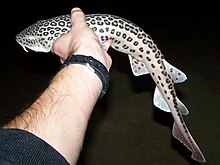Leopard catshark
| Leopard catshark | |
|---|---|

| |
| Leopard catshark photographed at a reef at False Bay in Cape Town, South Africa | |
| Scientific classification | |
| Domain: | Eukaryota |
| Kingdom: | Animalia |
| Phylum: | Chordata |
| Class: | Chondrichthyes |
| Subclass: | Elasmobranchii |
| Subdivision: | Selachimorpha |
| Order: | Carcharhiniformes |
| Family: | Scyliorhinidae |
| Genus: | Poroderma |
| Species: | P. pantherinum
|
| Binomial name | |
| Poroderma pantherinum (J. P. Müller & Henle, 1838)
| |

| |
| Range of the leopard catshark | |
| Synonyms | |
|
Poroderma marleyi Fowler, 1934
* ambiguous synonym | |
The leopard catshark (Poroderma pantherinum) is a
Mainly
Taxonomy

Because of its highly variable color pattern, the leopard catshark has historically been known under a multitude of names. In an 1837 issue of Proceedings of the Zoological Society of London, Scottish physician and
Subsequent authors have recognized these names as based on pattern variants of the leopard catshark; resolving the identity of P. marleyi proved especially problematic and it was not confirmed to be a
Distribution and habitat
The leopard catshark inhabits the
Description

The leopard catshark is the smaller and slimmer of the two Poroderma species. The head and snout are short and slightly flattened, with a somewhat pointed snout tip. Each nostril is split into tiny incurrent and excurrent openings by a three-lobed flap of skin in front, of which the central lobe forms a slender barbel that reaches past the mouth. The horizontally oval eyes are equipped with rudimentary nictitating membranes (protective third eyelids) and placed rather high on the head, with a thick ridge running under each. The mouth is wide and arched, with short furrows at the corners extending onto both jaws; the upper teeth are exposed when the mouth is closed. There are 18–30 and 13–26 tooth rows on either side of the upper and lower jaws respectively. The teeth have a narrow central cusp with a pair of small lateral cusplets; those of adult males are slightly more curved than those of females.[5][7]
The body is rather laterally compressed and tapers towards the tail, with two
The background color of the leopard catshark ranges from off-white to glossy jet black above and white to almost black below, sometimes with an abrupt transition between the two. Overlaid is a striking pattern of black markings variously combining small to large spots, blotches, complete to incomplete rosettes, and/or short to long lines, that may extend almost to the midline of the belly. There are four named forms: 'typical', with
Biology and ecology
The slow-swimming leopard catshark generally spends the day resting inside caves or crevices, either alone or in groups. At night, it moves towards the shore to actively forage for small

The leopard catshark is
Human interactions


Quite common within its range,[10] the leopard catshark is harmless to humans. It is a popular subject of public aquariums because of its small size, attractive appearance, and hardiness.[15] The aquarium trade supports a minor fishery that targets the two Poroderma species.[5] This shark is regularly caught incidentally by commercial and recreational fishers, and almost invariably discarded despite being edible. Nevertheless, fishing mortality is likely to be high as many fishers using line gear make a point to kill hooked sharks, seeing them as pests that "steal" bait.[5][10] The International Union for Conservation of Nature (IUCN) presently assesses the leopard catshark as least concern, though notes that its inshore habitat is heavily fished and otherwise impacted by human activity. The possible distribution of this shark across many small, distinct populations also warrants additional investigation and monitoring.[1]
References
- ^ . Retrieved 19 November 2021.
- ^ Smith, A. (1837). "On the necessity for a revision of the groups included in the Linnean genus Squalus". Proceedings of the Zoological Society of London. 1837 (5): 85–86.
- ^ Müller, J.; Henle, J. (1838). Systematische Beschreibung der Plagiostomen. Verlag von Veitund Comp. pp. 13–14.
- ^ Fowler, H. W. (January 20, 1934). "Descriptions of new fishes obtained 1907 to 1910, chiefly in the Philippine Islands and adjacent seas". Proceedings of the Academy of Natural Sciences of Philadelphia. 85: 233–367.
- ^ .
- ^ Eschmeyer, W.N., ed. pantherinum, Scyllium Archived 2012-03-05 at the Wayback Machine. Catalog of Fishes electronic version (May 6, 2010). Retrieved on May 18, 2010.
- ^ ISBN 92-5-101384-5.
- ^ Froese, Rainer; Pauly, Daniel (eds.) (2010). "Poroderma pantherinum" in FishBase. May 2010 version.
- ISBN 0-930118-18-9.
- ^ ISBN 1868253945.
- ^ Lechanteur, Y.A.R.G.; Griffiths, C.L. (October 2003). "Diets of common suprabenthic reef fish in False Bay, South Africa". African Zoology. 38 (2): 213–227.
- S2CID 85274789.
- ^ .
- .
- ^ a b Bester, C. Biological Profiles: Leopard Catshark. Florida Museum of Natural History Ichthyology Department. Retrieved on May 18, 2010.
- .
- PMID 12194487.
External links
- Poroderma pantherinum, Leopard catshark at FishBase
- Biological Profiles: Leopard Catshark at Florida Museum of Natural History Ichthyology Department

